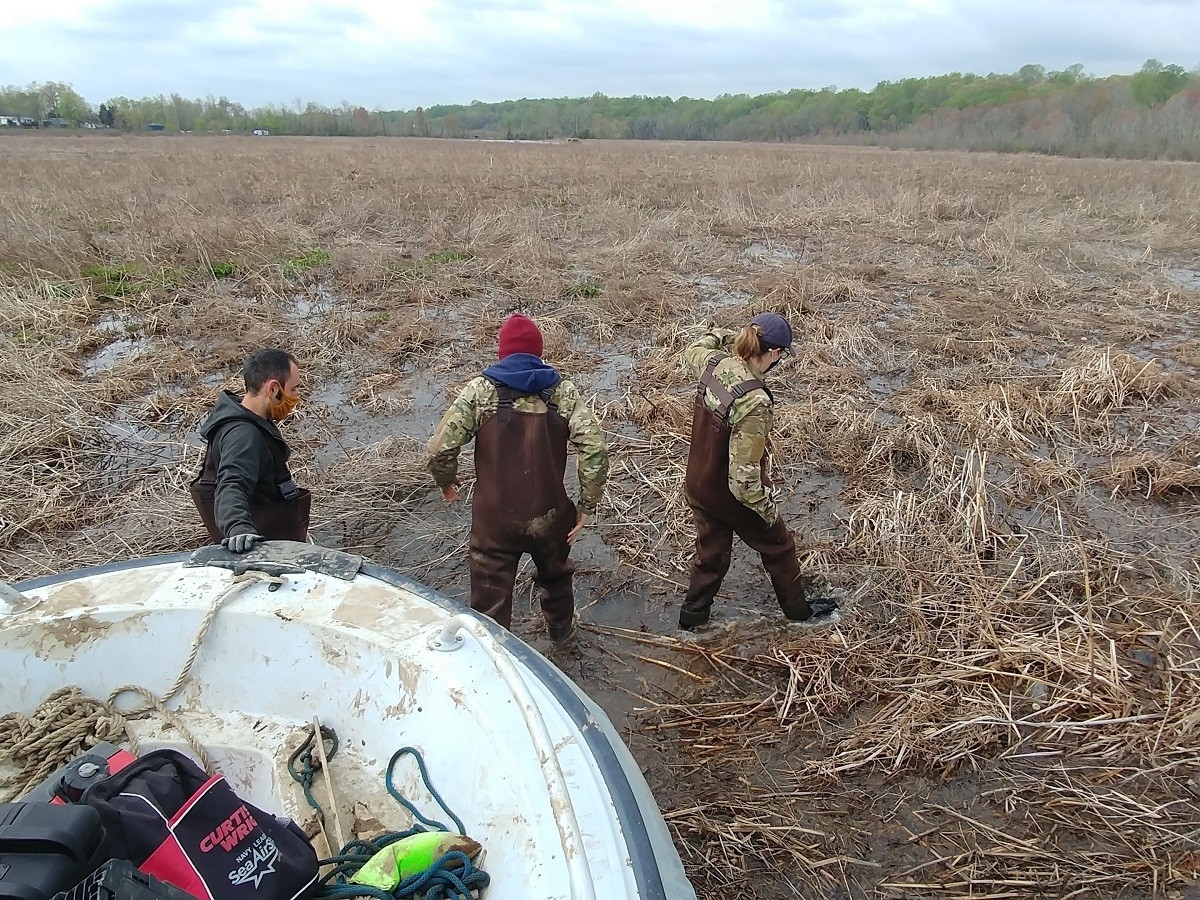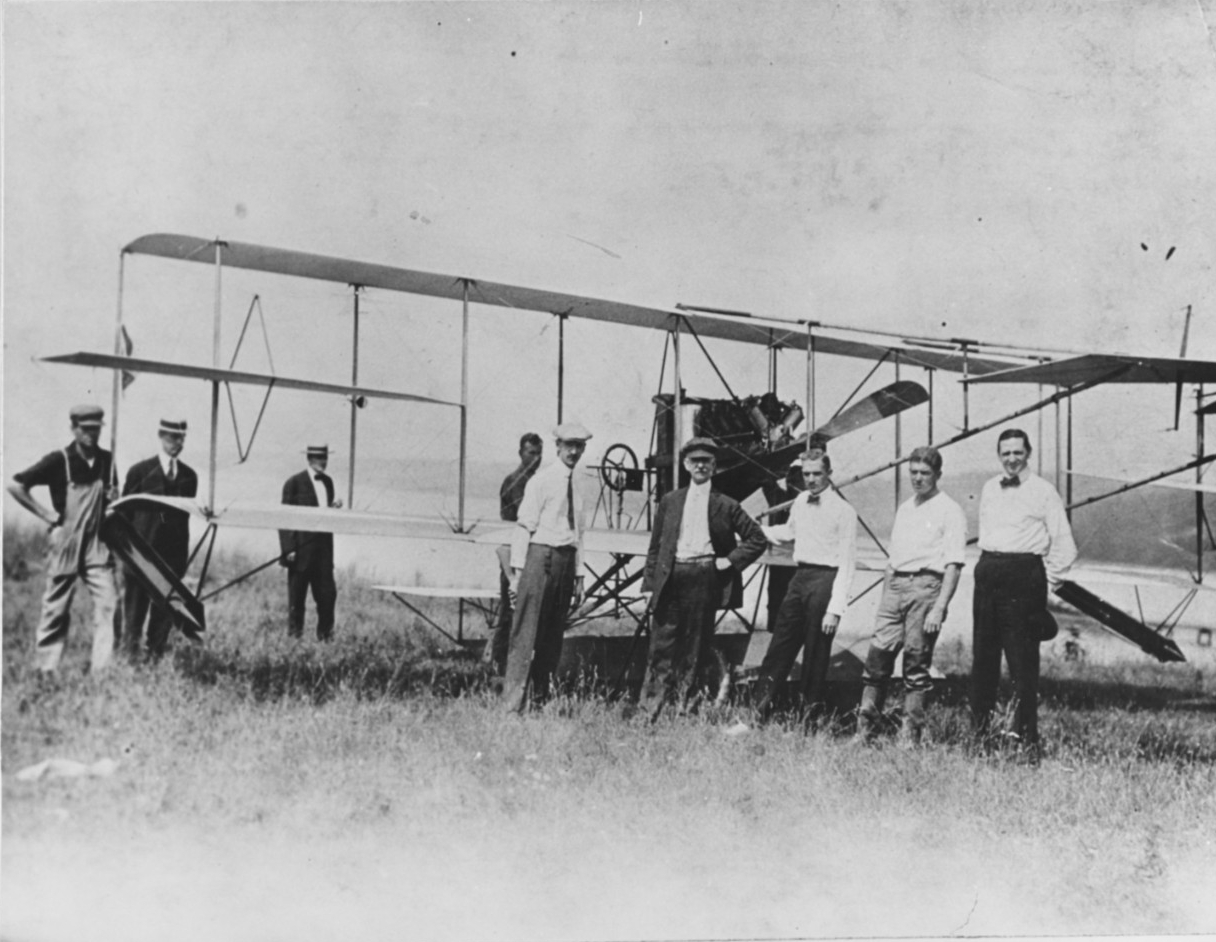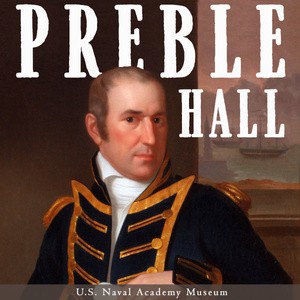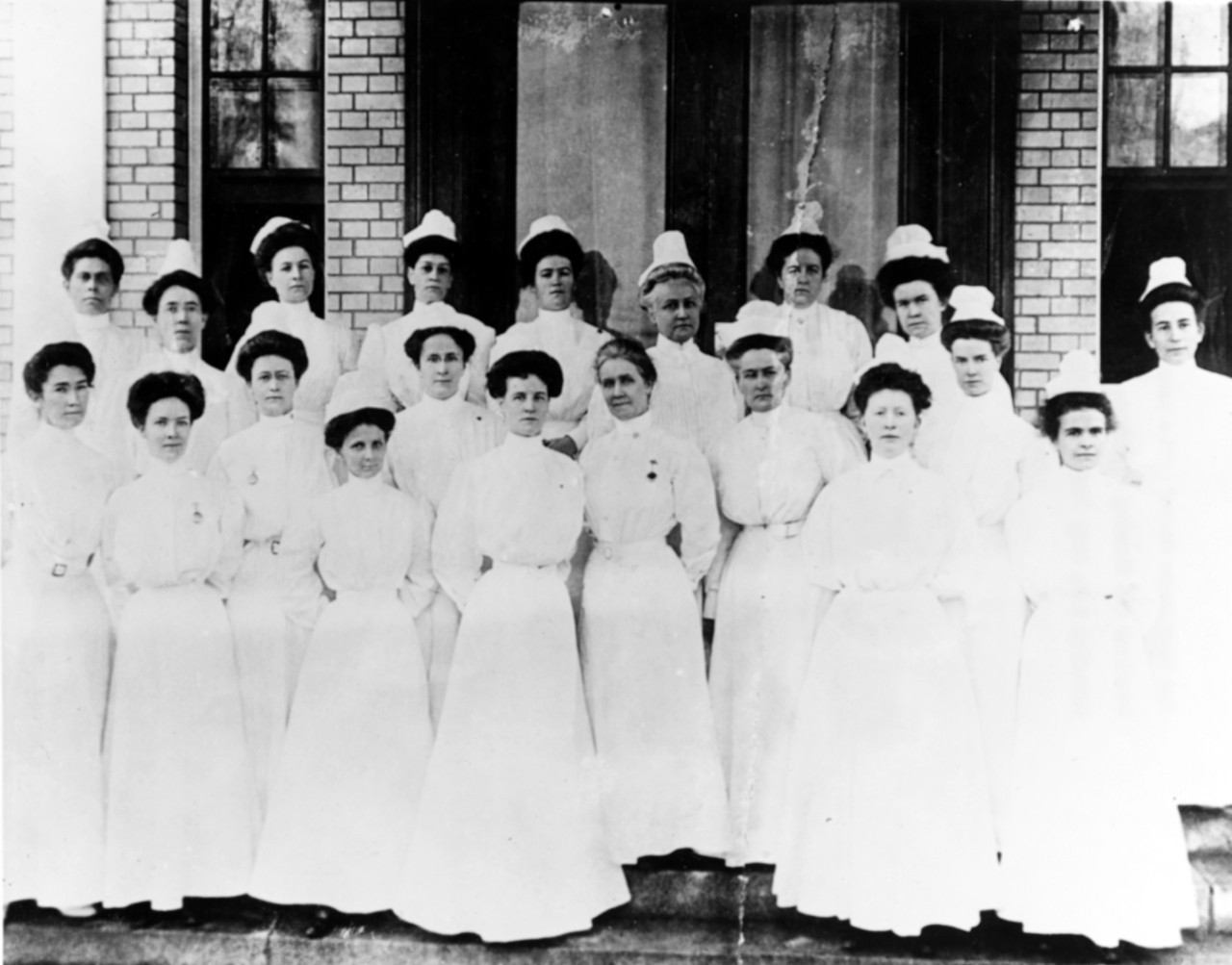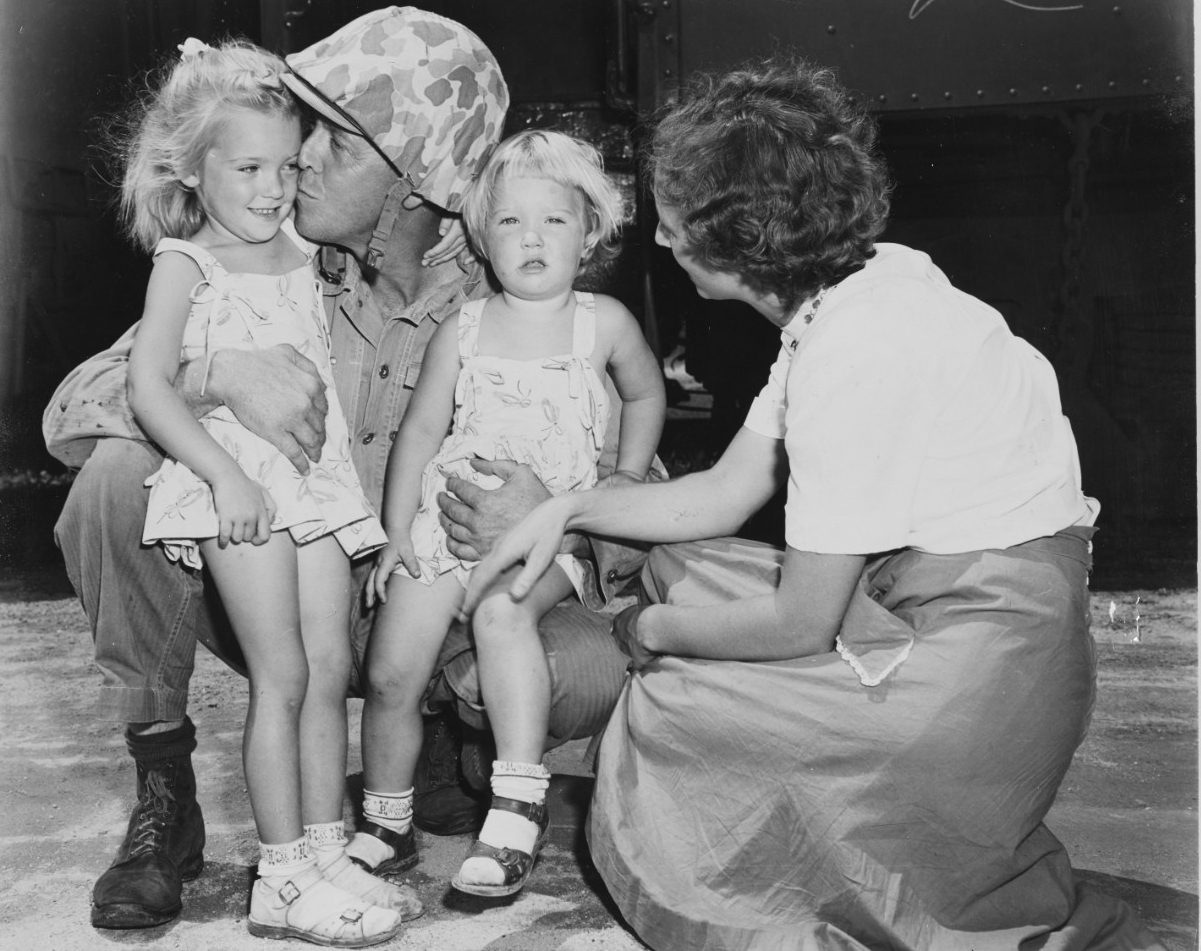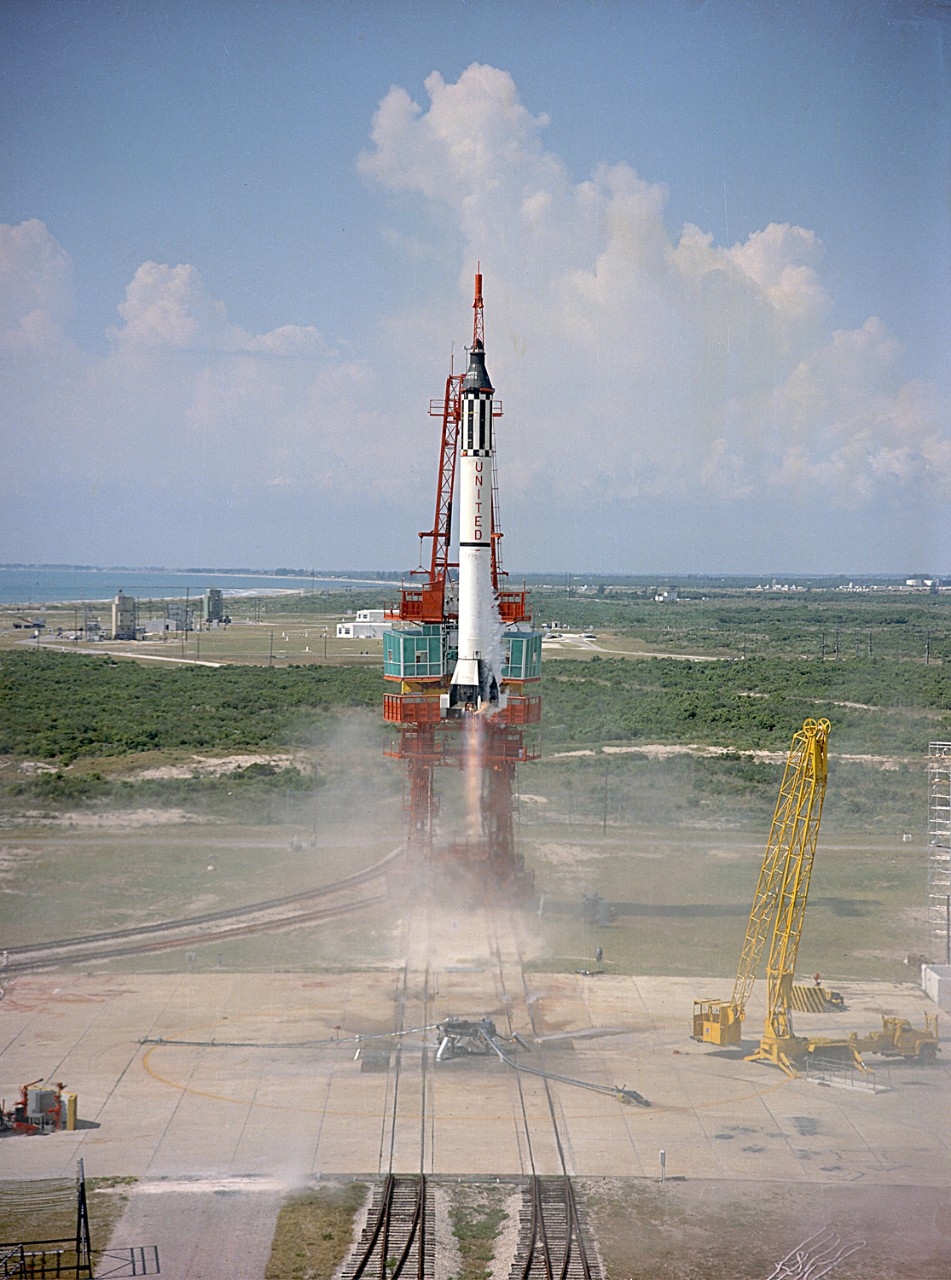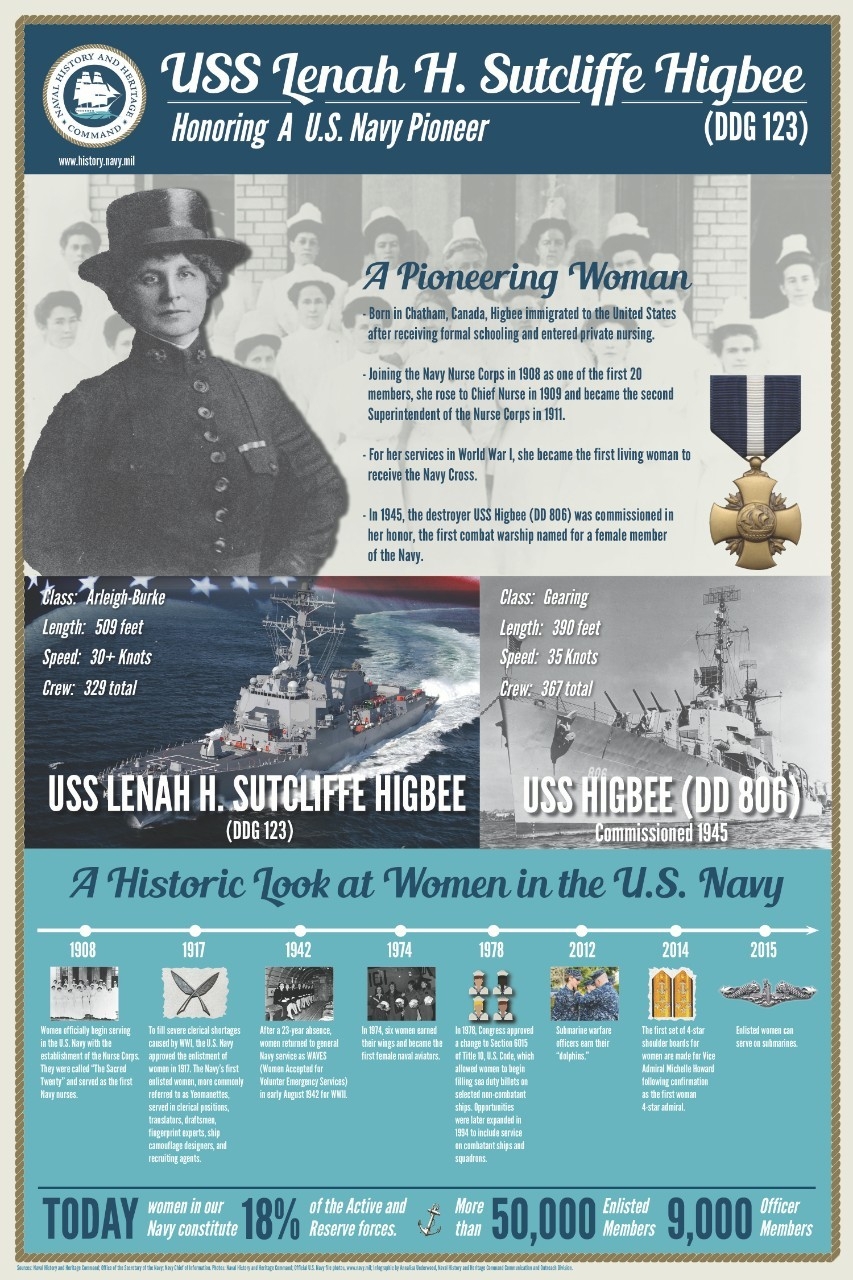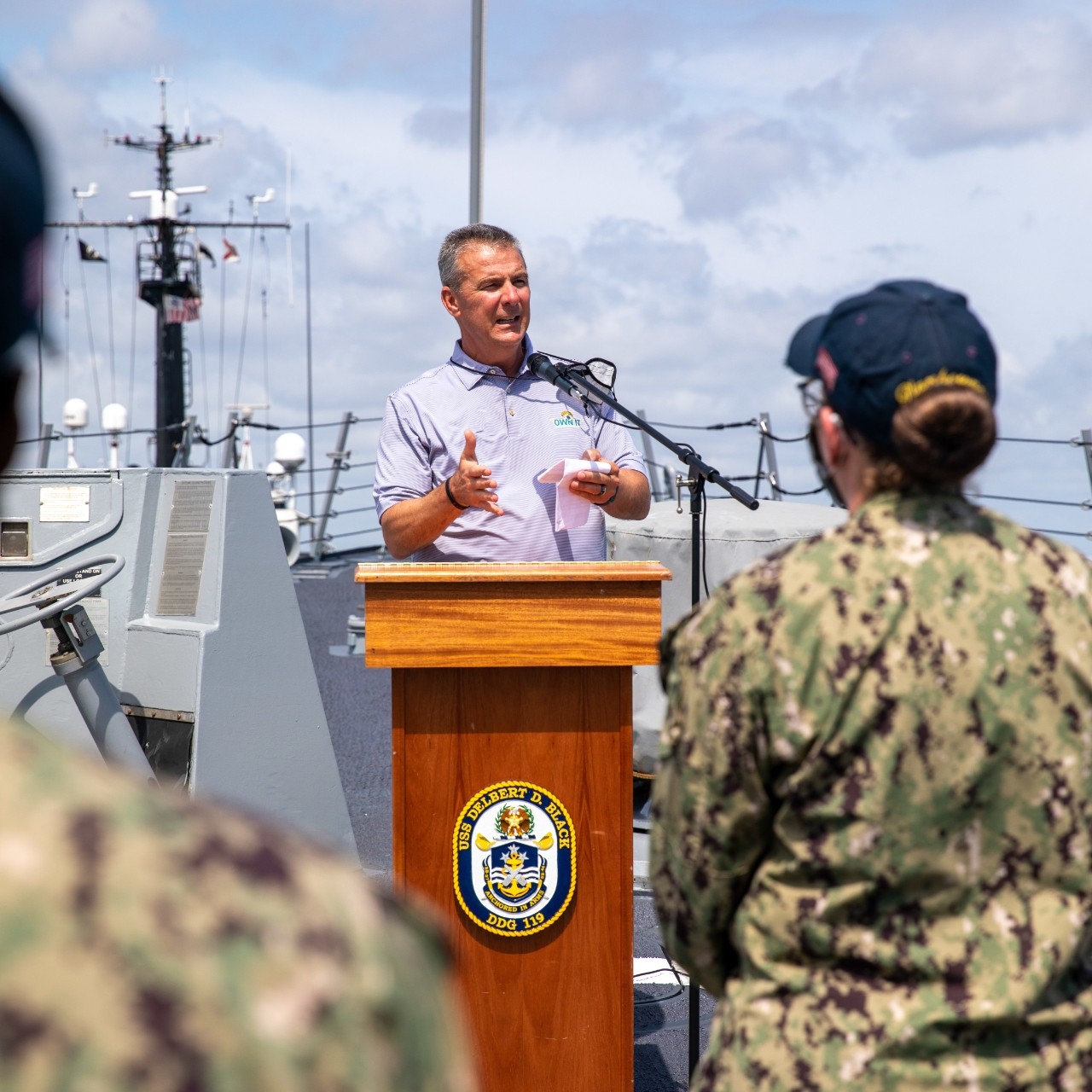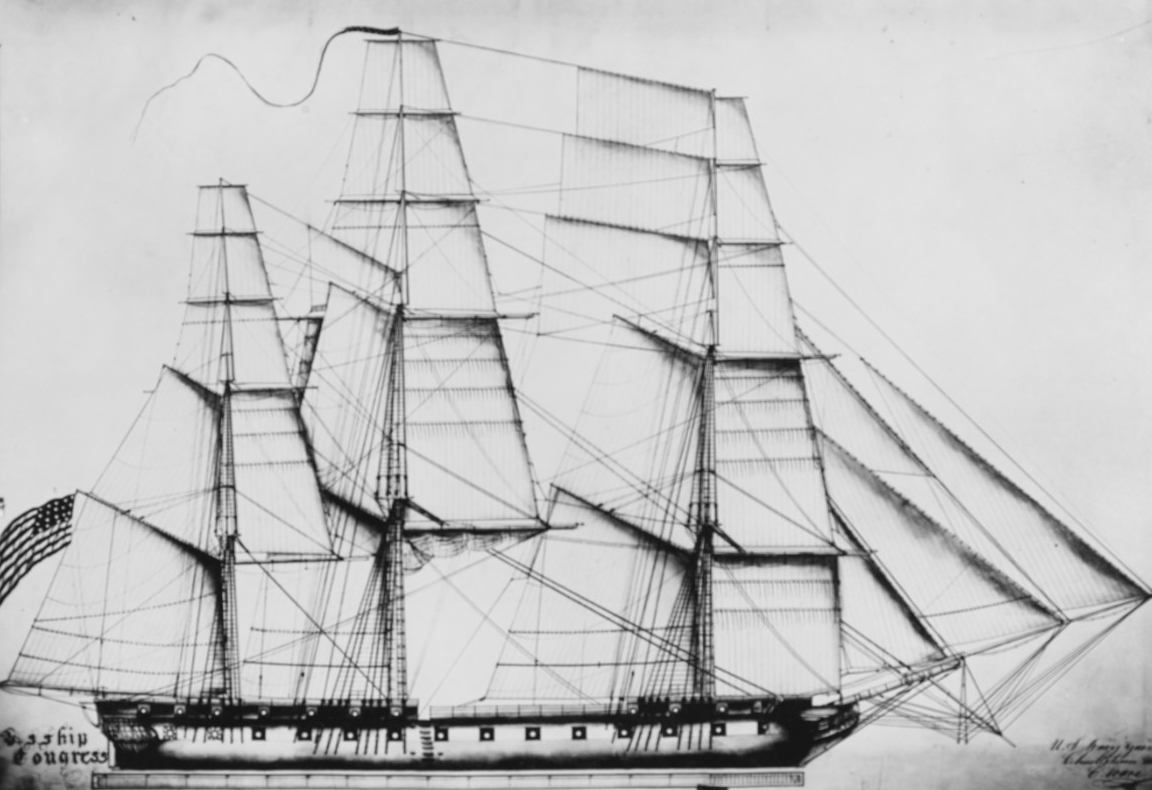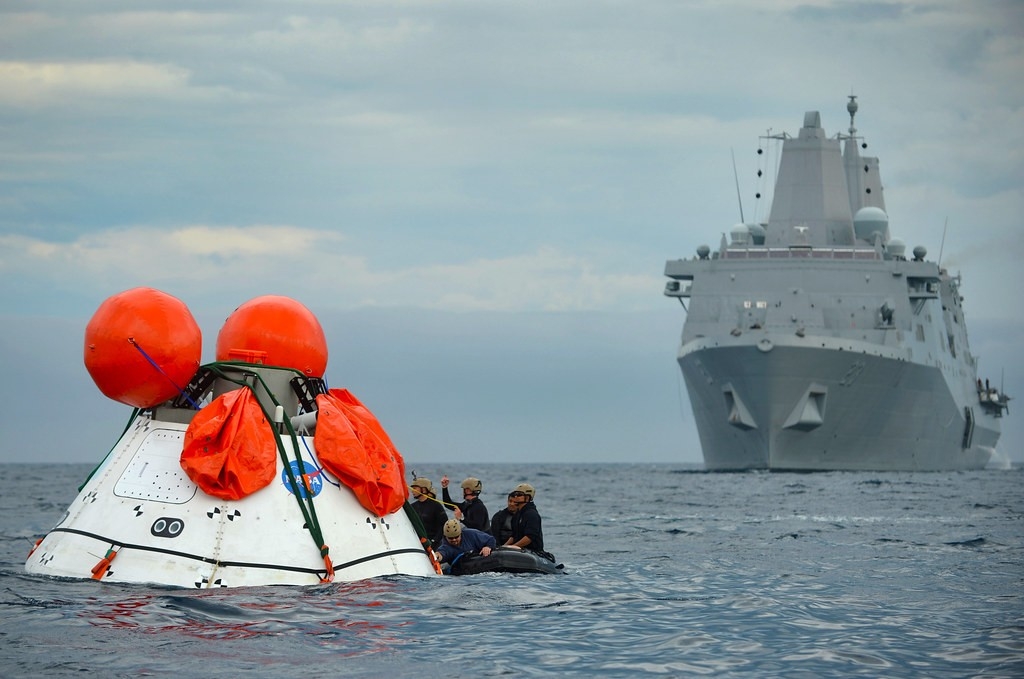Compiled by Brent Hunt, Naval History and Heritage Command’s Communication and Outreach Division
NHHC Archaeology by Land and by Sea (and Now by Air)
NHHC’s Underwater Archaeology branch recently collaborated with NAVAIR UX-24 to complete an aerial magnetometer survey over a marshy section of the Patuxent River where it is thought remains of naval vessels from the War of 1812 were buried. Between 2009 and 2011, UAB, along with Maryland Historic Trust and Maryland State Highways Administration, relocated, mapped, and excavated what is believed to be the gunboat Scorpion—flagship of Commodore Joshua Barney‘s Chesapeake Flotilla. In August 1814, after months of staving off British naval attacks and encroachments on the nation’s capital, the flotilla was ordered to be scuttled by Secretary of the Navy William Jones. Scorpion, along with 15–16 other vessels, were burned on the upper Patuxent River. Navy researchers believe the scuttled vessels are buried under the sediment in the river and may be detectable by a marine magnetometer given the amount of iron ordnance, anchors, ballast, and fasteners that could still be present. Scorpion was buried under approximately 4–8 feet of sediment below the river bottom and was found to have a strong magnetic signature. Ongoing research into the possible migration of the Patuxent River since 1814 suggests the remaining flotilla vessels could also be buried underground or in marshland adjacent to the current river. For more on the survey, read the blog by NHHC’s Dr. George Schwarz at The Sextant.
Happy Birthday, Naval Aviation!
On May 8, 1911, 110 years ago, Capt. Washington I. Chambers prepared the requisition for the first U.S. Navy seaplane, the A-1 Triad, marking the birth of naval aviation. Before the Navy purchased the aircraft, it had a keen interest in aviation. In 1910, the Navy appointed an aviation officer, Eugene Ely, who aviation pioneer Glenn Curtiss offered to train for free at his aviation camp. Ely, whose accomplishments of firsts in naval aviation are many, demonstrated that an aircraft could take off and land on a ship. From those humble beginnings, the Navy’s aircraft inventory has grown exponentially in both size and capability. Naval aviation has been pivotal during peacetime and war, and its capabilities are the envy of the world. Happy Birthday, Naval Aviation!
Preble Hall Podcast
In a recent naval history podcast from Preble Hall, Professor Matthew Dziennik and Marine Corps Capt. Chris Hemler—in this premiere episode of a new series from the U.S. Naval Academy History Department—interview Professor Brian VanDeMark about his book, Road to Disaster: A New History of America's Descent into Vietnam. The Preble Hall podcast, conducted by personnel at the U.S. Naval Academy Museum in Annapolis, MD, interviews historians, practitioners, military personnel, and other experts on a variety of naval history topics from ancient history to more current events.
National Nurses Day—May 6
National Nurses Day is celebrated annually on May 6 to raise awareness on the important role nurses play in society. The day marks the beginning of National Nurses Week, which ends on May 12, the birthday of Florence Nightingale (1820–1910). On May 13, 1908, 113 years ago, President Theodore Roosevelt signed the Naval Appropriations Bill authorizing the establishment of the Navy Nurse Corps. The original cadre of women to serve in the U.S. Navy as nurses were known as the “sacred twenty.” The group included Lenah Sutcliff Higbee, the first female to receive the Navy Cross. For more on Navy nurses and Navy medicine, go to NHHC’s website.
Military Spouse Appreciation Day—May 7
On May 7, National Military Spouse Appreciation Day will be celebrated to honor the contributions of the military spouse. America’s military spouses are the backbone of support for our nation’s military and are the silent heroes essential to the strength of the nation. Their service to this country is as important as that of service members in that they are there during the mission, deployments, reintegration, and reset. Military spouses embody service to our country and love for the service member who carries out the duties that keep our country safe. Especially on Friday, May 7, thank a military spouse for their service.
First American in Space—60 Years Ago
On May 5, 1961, Navy Cmdr. Alan Shepard, Jr., made the first U.S. manned space flight. On the flight, Shepard did not orbit Earth, but ascended 116 miles into space before his splash-down. The flight lasted about 15 minutes. USS Lake Champlain was selected as the primary recovery ship for the flight. Lake Champlain sailed to the recovery area on May 1 and was on station when Sheppard splashed down in spacecraft Freedom 7, some 300 miles downrange from Cape Kennedy, FL. Helicopters from the carrier visually followed the descent of the capsule and were over the astronaut two minutes after the spacecraft hit the water. The crew skillfully recovered Sheppard and Freedom 7 and carried them safely to Lake Champlain's flight deck. Shepard, who suffered from an inner ear disorder that was eventually corrected by surgery, would not return to space until about 10 years later. He was the commander of the Apollo XIV mission, Jan. 31–Feb. 9, 1971. Shepard’s Apollo mission was the third manned lunar landing. For more on the Navy’s role in space exploration, go to NHHC’s website.
Ship Named after Navy Nurse Lenah Higbee Christened
The U.S. Navy recently christened USS Lenah Sutcliffe Higbee during a ceremony at the Ingalls Ship Yard in Pascagoula, MS. The Arleigh Burke–class destroyer holds special meaning for the Navy medicine community. The ship’s namesake—Lenah Higbee—entered the service in 1908 and became part of the “sacred twenty,” the first nurses (and women) in the U.S. Navy. Just three years later, Higbee rose to the leadership of the corps, becoming its second superintendent—the forerunner of today’s Director of Nurse Corps. “As the 26th Director of the Navy Nurse Corps, I recognize that I am here in no small part because of the vision, initiative, and conspicuous achievements of this great warship’s namesake,” said Rear Adm. Cynthia A. Kuehner. “As the second superintendent, she led the Navy Nurse Corps with awe-inspiring distinction. In this evening’s ceremony, we celebrate her legacy. We honor her service. And we ensure that the permanence of her indomitable spirit is enshrined and revered by all who behold her.” For more, read the U.S. Navy press release. For more on women in the U.S. Navy, go to NHHC’s website.
Jaguars Coach Urban Meyer visits USS Delbert D. Black
Jacksonville Jaguars coach Urban Meyer recently visited USS Delbert D. Black at her homeport of Naval Station Mayport, FL, to show the crew his appreciation of their service. He began the visit by addressing the ship’s leadership and crew, and then led a “Q and A session” with the socially distanced, fully vaccinated contingent of the crew. “Heroes today come at very little expense: you score a touchdown, you throw a touchdown pass or you coach a good team and you become a hero,” said Meyer. “I don’t agree with that. I am staring at the true heroes in front of me—all of you. On behalf of our Jaguars football team, the players and coaches, thank you.” Delbert D. Black was commissioned Sept. 26, 2020, in Port Canaveral, FL. She is named for the first Master Chief Petty Officer of the Navy, the highest possible enlisted rank and the enlisted representative to the Chief of Naval Operations. Selected by the Navy in 1967, Black oversaw the establishment of the senior enlisted advisor position, which eventually became known as Command Master Chief. For more, read the U.S. Navy press release.
Webpage of the Week
This week’s Webpage of the Week is new to NHHC’s notable ships. Frigate Congress was launched on Aug. 15, 1799, under the command of Capt. James Sever. The ship was one of six frigates authorized by Congress with passage of the Naval Act of 1794. Congress, designed by Joshua Humprheys and built by naval constructor J. Hackett at Portsmouth, NH, had construction interrupted temporarily upon conclusion of a peace treaty with Algiers, but construction resumed when hostilities began with France. During the Quasi-War with France, French privateers regularly ransacked American ships, claiming their goods as prizes and then scuttling or sailing the captured ships to French ports. After outfitting, Congress set sail in December 1799 to protect American interests from the unlawful French privateers. On her maiden voyage, in company with frigate Essex, Congress lost her mast only six days into the cruise and had to return to the United States. Following repairs at Hampton Roads, VA, Congress set sail for the West Indies in July 1800. On Aug. 29, she recaptured merchant brig Experiment, which had been seized days earlier. For the next year, Congress sailed in the vicinity of Santo Domingo before returning to Boston in April 1801, and thereafter, was placed in ordinary at Washington, DC. For more, check out the page today. It contains a short history, suggested reading, and selected imagery.
Today in Naval History
On May 4, 2013, USS Anchorage was commissioned in her namesake city. The San Antonio–class LPD (amphibious transport, dock) is the second ship to be named after the Alaskan city. The ship, homeported in San Diego, CA, is capable of responding to crises worldwide to include human assistance and disaster relief. The ship is also capable of responding to emergent missions such as it did in 2014 when it was tasked in recovery efforts of NASA’s Orion space capsule. On Dec. 5, NASA launched Orion from Cape Canaveral, FL, to reestablish America’s manned space program. The spacecraft made two orbits of the Earth during the four-and-a-half-hour mission and splashed down in the Pacific. Anchorage, along with USNS Salvor and other supporting units, recovered Orion’s crew module, forward bay cover, and parachutes. A bridge team specially trained for the operation maneuvered Anchorage alongside Orion and lowered the ship’s small boats to retrieve the capsule. Divers attached lines from the boats to guide the capsule toward Anchorage, where a NASA-designed winch hauled the module into the well deck. For more on the Navy’s role in space exploration, visit NHHC’s website.

